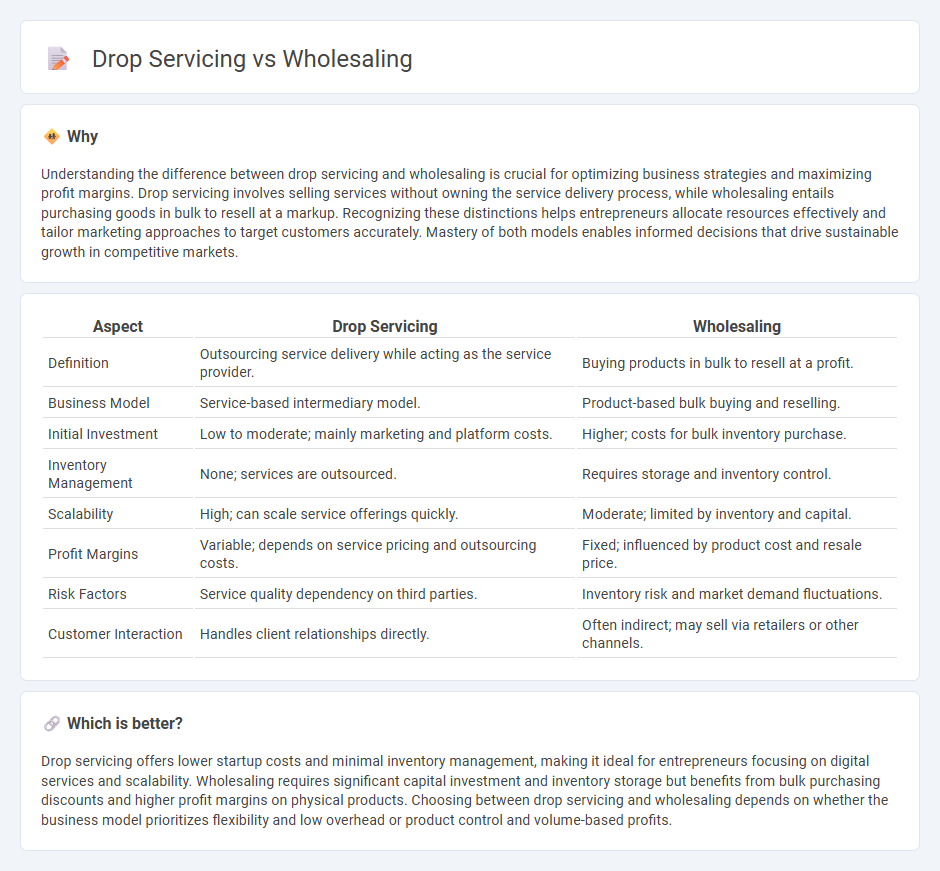
Drop servicing involves selling services performed by third-party providers, allowing entrepreneurs to manage service delivery without directly executing the tasks. Wholesaling focuses on purchasing products in bulk at discounted rates to resell them to retailers or consumers, leveraging volume for profit margins. Explore the key differences and benefits of drop servicing versus wholesaling to determine the best fit for your commerce strategy.
Why it is important
Understanding the difference between drop servicing and wholesaling is crucial for optimizing business strategies and maximizing profit margins. Drop servicing involves selling services without owning the service delivery process, while wholesaling entails purchasing goods in bulk to resell at a markup. Recognizing these distinctions helps entrepreneurs allocate resources effectively and tailor marketing approaches to target customers accurately. Mastery of both models enables informed decisions that drive sustainable growth in competitive markets.
Comparison Table
| Aspect | Drop Servicing | Wholesaling |
|---|---|---|
| Definition | Outsourcing service delivery while acting as the service provider. | Buying products in bulk to resell at a profit. |
| Business Model | Service-based intermediary model. | Product-based bulk buying and reselling. |
| Initial Investment | Low to moderate; mainly marketing and platform costs. | Higher; costs for bulk inventory purchase. |
| Inventory Management | None; services are outsourced. | Requires storage and inventory control. |
| Scalability | High; can scale service offerings quickly. | Moderate; limited by inventory and capital. |
| Profit Margins | Variable; depends on service pricing and outsourcing costs. | Fixed; influenced by product cost and resale price. |
| Risk Factors | Service quality dependency on third parties. | Inventory risk and market demand fluctuations. |
| Customer Interaction | Handles client relationships directly. | Often indirect; may sell via retailers or other channels. |
Which is better?
Drop servicing offers lower startup costs and minimal inventory management, making it ideal for entrepreneurs focusing on digital services and scalability. Wholesaling requires significant capital investment and inventory storage but benefits from bulk purchasing discounts and higher profit margins on physical products. Choosing between drop servicing and wholesaling depends on whether the business model prioritizes flexibility and low overhead or product control and volume-based profits.
Connection
Drop servicing and wholesaling are connected through their shared focus on intermediary roles in commerce, where businesses facilitate the distribution of services or goods without holding inventory. Drop servicing involves selling digital services sourced from freelancers, while wholesaling involves purchasing products in bulk to sell to retailers or other businesses. Both models leverage supply chain efficiency and scalability to optimize profit margins and reduce operational costs.
Key Terms
Inventory Management
Wholesaling relies heavily on efficient inventory management to maintain stock levels, reduce holding costs, and prevent stockouts, ensuring timely product availability for customers. Drop servicing eliminates physical inventory concerns by offering service-based solutions, allowing businesses to focus on managing client relationships and service delivery workflows without hardware storage constraints. Explore the strategies each model uses to optimize inventory handling and operational efficiency.
Service Fulfillment
Wholesaling involves purchasing products in bulk and selling them at a markup, optimizing inventory management and direct product delivery. Drop servicing focuses on outsourcing service tasks to third-party providers, emphasizing seamless service fulfillment and client satisfaction without handling the core service execution. Explore our in-depth analysis to understand which model suits your business goals best.
Supply Chain
Wholesaling involves purchasing large quantities of products from manufacturers or distributors and selling them in smaller lots to retailers or consumers, relying heavily on physical supply chain logistics such as inventory management, warehousing, and shipping. Drop servicing bypasses physical products entirely, focusing instead on selling services provided by third-party freelancers or agencies, with a virtual supply chain centered on service delivery, client management, and digital coordination. Explore the nuances of managing supply chains in wholesaling versus drop servicing to optimize your business model effectively.
Source and External Links
Wholesaling - Wikipedia - Wholesaling is the sale of goods in bulk, usually purchased from manufacturers at discounted rates, to retailers, businesses, or other wholesalers rather than end consumers, often involving sorting, repacking, and redistribution processes.
Wholesale real estate: A beginner's guide | Rocket Mortgage - Real estate wholesaling involves contracting a property at a discounted price and selling the contract to an investor for a higher price, enabling the wholesaler to profit without purchasing the property outright.
How to Start Wholesaling Real Estate in 7 Steps - SmartAsset - Wholesaling real estate is a strategy requiring minimal capital where a wholesaler contracts a property then assigns that contract to a buyer for a fee, offering a fast way to profit without owning or renovating the property.
 dowidth.com
dowidth.com